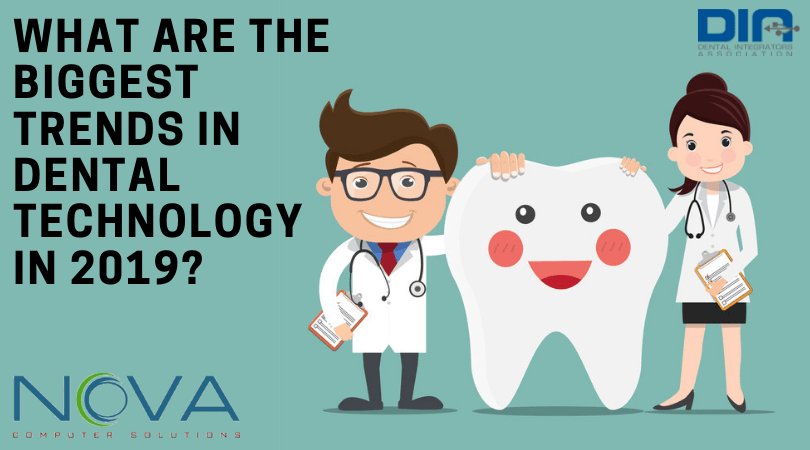The digital age is transforming the dental field. Current and evolving technologies will likely be key players in improving dental services in the near future.

Technology is transforming the way businesses and other entities operate. Like the healthcare industry and other sectors, the dental field has begun to reap the benefits of going digital, and this trend is expected to gain momentum in the coming years. Consider the biggest anticipated technology trends in dentistry in 2019.
The application of three-dimensional printing to dental technology has become one of the fastest-growing developments in the industry. Dental labs are using this new capability to keep tasks in-house that would otherwise be outsourced. Dental practices’ increasing reliance on 3D printing has been facilitated by the heightened availability of a variety of materials, such as resins. Dentists now can print denture bases and surgical guides. Another advantage of 3D printing is that it can be done more quickly and efficiently than ever before. When dentists no longer have to delegate the creation of oral apparatus to a third party, they can make these products and devices more readily available to patients, often at a lower cost. Industry leaders predict that the next big breakthrough in 3D printing in the oral healthcare arena will be the advent of permanent crowns, notes Matt Alles, digital solutions marketing manager for Straumann North America.
With so many applications now connected to the cloud, it’s no surprise that this versatile platform has enhanced the capabilities of dental technology, too. The healthcare field has already been transformed by the arrival of integrated systems, which allow clinicians and patients alike to access information from any location in real time. This development, coupled with the use of analytics and even business intelligence in dentistry, has exponentially enhanced computing capabilities in this field.
Increasingly, dentists are using automated systems to maintain patient records and share information with practitioners in multiple locations. Clinicians and staff can access any data they need– administrative, clinical and financial– within the same system. Like the healthcare industry, dentistry is overcoming the barriers of information silos and limited software applications. Cloud-based computing has also reduced the need to rely on IT personnel, since the software comes with round-the-clock technical support. Dental software has become more intuitive over the years, too, making it much easier to use.
The cloud also makes it possible to access data on a more significant number and variety of devices. What used to only be available on a small amount of desktop computers can now be retrieved via laptop, smartphone and tablet as well. Tech developers have responded to this trend by improving communication channels– such as text and chat– and data security.
Because today’s milling units are highly-precise, they give clinicians much-needed flexibility in customizing prosthetic devices for patients. Five-axis mills are capable of using a wide variety of materials to create virtually any type of oral apparatus. According to Steve Braykovich, president and CEO of Axsys Dental Solutions, developments in milling have greatly improved the durability of prosthetics, as they are more resistant to chipping and their surface finishes are of higher quality than in the past.
Improvements to open-source software have paralleled the development of milling capabilities. Programs use algorithms and other features that enable clinicians to streamline workflows, optimizing overall productivity and service delivery.
The days when patients had to bite down on a mouthful of putty to obtain impressions of their teeth are becoming a thing of the past. Dental technology has advanced to the point that images that once had to be taken individually using a foot pedal can now be captured with scanners that absorb large amounts of data in a matter of seconds. Current software allows for higher-quality renderings than those created through more traditional means. Information can be gathered much more quickly and conveniently– both for the patient and the practitioner. Today’s methods for taking impressions can also identify weaknesses in the process so that missing data can be supplied seamlessly, improving the accuracy of images captured and the speed at which this task can be accomplished.
Beginning in the not-so-distant future, dental tools and procedures will become more highly-digitized, allowing for painless, less invasive treatment. Toward that end, dentists are discovering the benefits of laser technology, which eliminates the need for anesthesia, shortens recovery times, and is especially beneficial for patients with special needs or those who don’t like needles.
Dentists also recognize the power of social media to educate patients about the latest techniques and technologies. Patient education can go a long way toward encouraging people to visit the dentist more often. Furthermore, digital outreach can be used to empower people to take an active role in promoting oral health between visits to a clinician. Using social media allows practitioners to connect with an unprecedented number of people, as users can like and share posts or tag their friends in status updates and promotional messages. Of course, dentists can also use this tool in conjunction with more traditional forms of advertising to ensure that they reach a broader swath of the population.
Dr. John Flucke, technology editor for Dental Products Report, predicts that artificial intelligence and data mining will play a critical role in dentistry shortly. These innovations will likely allow for faster turnaround times when diagnosing and treating patients.
In 2019 and beyond, dental technology is expected to make treatment more comfortable and affordable. With the frenetic pace at which digital capabilities are evolving, these technologies will likely become even more highly-developed, allowing dental practices to carry out their work seamlessly. Dental practitioners can boost their bottom line while improving service delivery– essentially doing more with less, as is happening in the healthcare industry. The benefits of these technologies will, in turn, make patients more likely to see the dentist on a regular basis, improving oral health among the general population and providing additional resources for clinicians to continue to customize and optimize their services.